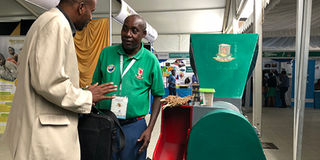Varsities showcase agricultural innovations

Egerton University agronomist, Prof Bernard Towett explains a point on how the simple sorghum thresher works to a guest during the Regional Universities Forum for Capacity Building in Agriculture (RUFORUM) held in Nairobi last week. The event showcased varied developments in agriculture. PHOTO | BRIAN OKINDA | NMG
What you need to know:
- Green-yellow beans and Light tan are much superior in quality, yields, mature faster and thrive in varied ecological conditions.
- The Light tan, on the other hand, is an improved version of the Canadian Wonder bean variety. The variety, according to Prof Towett, thrives in a wide range of ecological conditions, as well as yields higher.
- From University of Nairobi’s Seed Enterprise Management Institute (SEMI) at Kabete Campus, the development of tissue culture cassava plantlets will see an enhanced production of the planting material and hence an increase in the crop’s cultivation.
- Methuselah Nyamwange, from the Department of Biochemistry, Microbiology and Biotechnology at Kenyatta University, on the other hand, said with the low cost tissue culture production, the equipment, components and materials employed are available easily and cheaply providing an opportunity to undertake the process in a wide-range of settings.
The recent Regional Universities Forum for Capacity Building in Agriculture (RUFORUM) held in Nairobi saw the institutions of higher learning showcase their agricultural innovation.
From Egerton University, the new Chelalang bean variety stood out, but the plant breeder at the institution’s Agro-science Park, Prof Bernard Towett, said they have come up with two other new bean varieties.
Green-yellow beans and Light tan are much superior in quality, yields, mature faster and thrive in varied ecological conditions.
“The green-yellow variety, which is a cross between the Chelalang and the Katumani B1 (Kat B1), has the best qualities of both these varieties, making it a better option for cultivation,” said Prof Towett.
The Light tan, on the other hand, is an improved version of the Canadian Wonder bean variety. The variety, according to Prof Towett, thrives in a wide range of ecological conditions, as well as yields higher.
“Both these varieties, have neither gas nor acid when cooked, mature faster, yield more (seven to eight bags per acre for the Green-yellow and 10-12 bags per acre for the Light tan). By next year, they should be in the market,” said Prof Towett.
From the Jomo Kenyatta University of Agriculture Technology (JKuat), Prof Mary Abukutsa-Onyango has released nine new varieties of indigenous super vegetables such as African Nightshade, Vine spinach, Jute mallow, and Spider-plant, which are ready for commercialisation.
According to her, the qualities that cut across some of these varieties include being high in antioxidants, highly medicinal, high anthocyanin content, dense in micro-nutrients, early maturity and resilience to adverse conditions.
From University of Nairobi’s Seed Enterprise Management Institute (SEMI) at Kabete Campus, the development of tissue culture cassava plantlets will see an enhanced production of the planting material and hence an increase in the crop’s cultivation.
According to Rose Njeri from the Department of Crop Protection at the institution, the success of the production of tissue culture banana suckers provided a platform for their outspreading of the technology to cassava as they seek to enhance its cultivation and consumption, in the face of food insecurity situations.
Methuselah Nyamwange, from the Department of Biochemistry, Microbiology and Biotechnology at Kenyatta University, on the other hand, said with the low cost tissue culture production, the equipment, components and materials employed are available easily and cheaply providing an opportunity to undertake the process in a wide-range of settings.
Currently, the institution has also established low cost tissue culture options for bananas, sweet potato and cassava, which are readily available to farmers.





